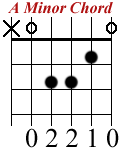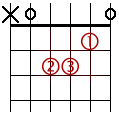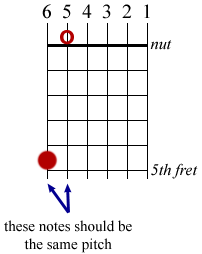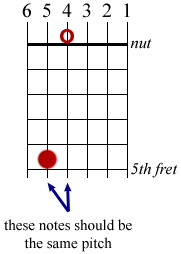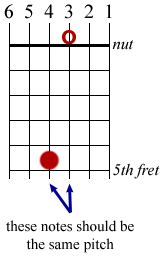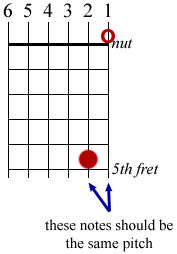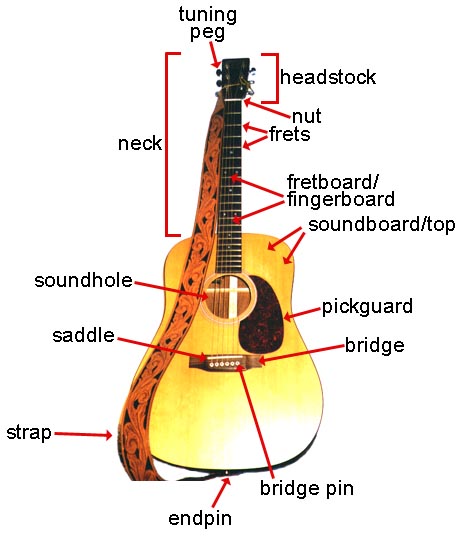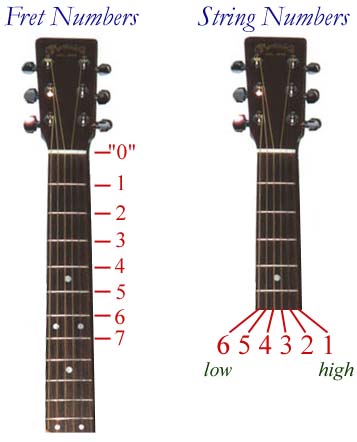The A Minor Chord
Here’s how you hold the A minor chord, this is one of the more popular chords and is actually quite easy to hold.
Here are the proper finger positions:
The Slide
The slide is the simplest technique for a beginning guitarist to learn. It gets its name from the technique: you actually slide your finger up or down the fretboard while fretting a string. A slide is represented in tab notation by this symbol:
+ +
e:---------|
B:-----6\5-|
G:---------|
D:-5/7-----|
A:---------|
E:---------|
The first slide is a slide on the 4th string from the 5th fret up to the 7th fret.
The second slide is a slide on the 2nd string from the 6th fret down to the 5th fret.
The slide is accomplished by fretting the desired note, picking the note, then moving your finger up to the desired higher note. Make sure you maintain pressure on the string as you slide, so the string is not muted. This is the most important part of the slide: making sure the string stays against the fretboard while you slide. You can also slide down, using the same technique but moving down the fretboard to a lower note.
And so had ended your first beginners guitar lessons.
The G Major Chord
This is how the G major chord is formed. Each way is equal so it will just depend on your fingers and what feels comfortable for you.
The proper fingers to use for the G major chord are shown below.
Styles of picking
There are two schools of acoustic guitar picking that have developed over time: the flatpickers, who use the small plastic picks; and the fingerpickers, who just use their fingers without a pick. I fall into the latter category, because I find fingerpicking to be much more liberating than using a pick, it feels better and its much easier to get the hang of.
You may also hear of a technique called “fingerstyle,” which is very similar to fingerpicking. Basically, fingerpicking is defined as playing only one string at a time, while fingerstyle players sometimes play two- or three-note chords using their fingers. However, the distinction between these two styles is rather worthless because most guitarists, including Jimmy Page, Eric Clapton, James Taylor, John Denver, Jim Croce play both styles at different times or even during the same song.
Most players use both styles, flatpicking and fingerpicking, at different times. Both have advantages and disadvantages depending on what sound you want to get, so it is all up to you. Even if you don’t fingerpick much, it is very helpful to know how to do it in case the need ever arises.
Tuning your Acoustic Guitar
Tuning may be the most important thing when learning to play an Acoustic Guitar. If you aren’t in tune, you will never sound good, no matter how incredible a player you are, everything and absolutely everything sounds like garbage. These pages are designed to teach you how to tune your guitar. Follow them step-by-step and you will be able to tune quickly and easily, without the need for an expensive electronic tuner.
The goal of tuning is to put your strings in tune with each other. You strings should be tuned to the following notes (low-to-high): EADGBE. This is called “standard tuning.” There are many other possible tunings, but I will not discuss those here.
The first step in tuning is to get a reference pitch. This will be the E on your sixth string. The accuracy of your tuning to this pitch when playing alone is relatively unimportant; I tend to tune to a pitch slightly below this to help me sing higher notes more easily. However, if you are playing in a group, it is absolutely imperative that you all tune to the same reference pitch, because if you don’t you will all be out of tune with each other.
The sound file below is an E on your sixth string. Tune your sixth string to it before you go on. To do this, play the pitch, then tune your 6th string until the pitch sounds exactly like the file. You may have to turn up your speaker volume to be able to hear the file well enough to tune.
Once you have tuned your sixth string to E, you can tune your fifth string to A based on your sixth string. Refer to the image below as you do this. It’s very simple, and the hardest part will be making sure that the open fifth string pitch sounds EXACTLY like the fretted sixth string. The procedure goes like this:
- Fret your sixth string at the 5th fret.
- Tune your open fifth string until it sounds exactly like the fretted sixth string.
Why does this work? Well, the sixth string 5th fret is an A, which is the same note as your open fifth string. Once you’re done, move on to the fourth string.
Tuning Your Fourth String
Once you have tuned your fifth string to A, you can tune your fourth string to D based on your fifth string. The procedure is exactly the same, but we’ve moved up a string:
- Fret your fifth string at the 5th fret.
- Tune your open fourth string until it sounds exactly like the fretted fifth string.
Why does this work? Well, the fifth string 5th fret is a D, which is the same note as your open fourth string. Once you’re done, move on to the third string.
Tuning Your Third String
Once you have tuned your fourth string to D, you can tune your third string to G based on your fourth string. The procedure is exactly the same, but we’ve moved up another string:
- Fret your fourth string at the 5th fret.
- Tune your open third string until it sounds exactly like the fretted fourth string.
Why does this work? Well, the fourth string 5th fret is a G, which is the same note as your open third string. Once you’re done, move on to the second string.
Tuning Your Second String
Once you have tuned your third string to G, you can tune your second string to B based on your third string. The procedure is similar, but this time we use the fourth fret instead of the fifth:
- Fret your third string at the 4th fret.
- Tune your open second string until it sounds exactly like the fretted third string.
Why does this work? Well, the third string 4th fret is a B, which is the same note as your open second string. Once you’re done, move on to the first string.
Tuning Your First String
Once you have tuned your second string to B, you can tune your first string to E based on your second string. We now return to fretting at the fifth fret:
- Fret your second string at the 5th fret.
- Tune your open first string until it sounds exactly like the fretted second string.
Why does this work? Well, the second string 5th fret is an E, which is the same note as your open first string.
You have now tuned your guitar! You may have to go back and slightly re tune certain strings to sound exactly right, but this will usually get you close enough. Just make sure you are as accurate as possible when tuning. Good luck, and if you have any questions, please let me know.
The notes on a guitar
The image that you see below is the fretboard of an Acoustic Guitar and the notes that each fret represent, now while this might seem a bit of a jumble now it will all make some sense soon but i put this image up so you can use it for reference later.
The parts of an Acoustic Guitar
These are the parts of an Acoustic Guitar, i know this might be the boring part of learning to play an Acoustic Guitar but if knowing the parts will help you later when i and other people will refer to them.
The image below shows the names of the frets and strings
The strings are numbered 1 through 6, with 6 being the lowest (thickest) string. The frets are numbered from 0, with higher numbers referring to higher pitches.
Types of Acoustic Guitars
Here’s step one on learning to play an acoustic guitar, know the different kinds of acoustic guitars.
Generally speaking there are two basic types of acoustic guitars available today: folk guitars and classical guitars. Folk guitars have steel strings, while classical guitars have nylon strings. The difference in string material causes an immense difference in sound. The style of playing is usually different as well: classical guitar is usually considered more of a “fine art” than folk guitar; folk guitars are more likely to be used in rock music and you will know the difference in the sound the moment you hear it. Eric Clapton plays both types of guitar on his performance on MTV Unplugged, but he does this to get different sounds rather than because he is playing different styles.
The sizes of the guitar bodies are usually different, with classical guitars being smaller. Folk guitars are usually manufactured in the popular “Dreadnought” size and are the typical guitars you see in pictures and videos, but other sizes are available. Folk guitars are also braced more strongly because the steel strings create greater tension than nylon strings.
which acoustic guitar should you learn on?
I started with a folk guitar and i do suggest you start with one too.


